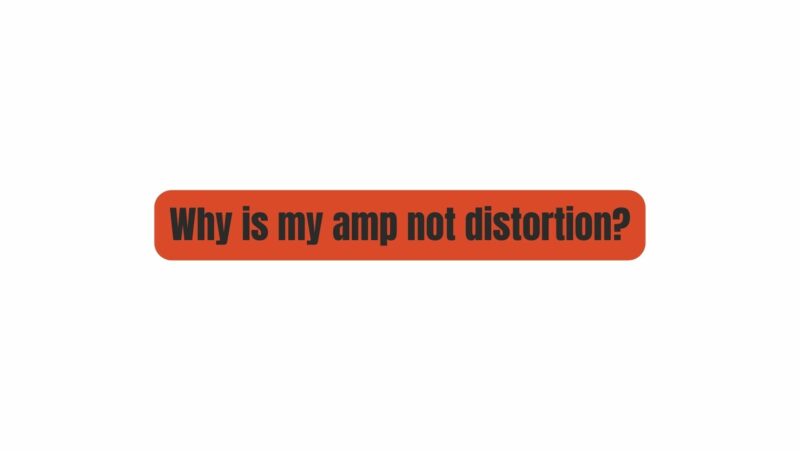Distortion is a beloved and essential element in many genres of music, from rock and blues to heavy metal. It can add grit, character, and intensity to your guitar tone. However, there are times when your amplifier might not deliver the desired distortion, leaving you with a clean, pristine sound. In this article, we will delve into the potential reasons why your amp is not distorting and provide solutions to help you achieve that coveted crunchy tone.
Understanding Distortion
Before we get into the reasons for a lack of distortion, let’s briefly understand what distortion is and why it’s an integral part of electric guitar playing.
Distortion is a form of audio signal processing where the amplitude of a sound wave is altered, resulting in a change in tonal quality. In the context of electric guitars and amplifiers, distortion typically occurs when the signal is pushed beyond its linear limits, causing it to “clip” or become compressed. This effect generates harmonics and overtones, producing the characteristic crunch, sustain, and aggressive sound associated with distorted guitar tones.
Reasons Your Amp May Not Be Distorting
- Volume Levels: One of the most common reasons your amp may not be distorting is that the volume level is not sufficiently high. Distortion often occurs when the amplifier is pushed into its higher gain stages. Try increasing the master volume or gain control on your amp to see if it results in more distortion.
- Gain Settings: Check the gain or distortion control on your amplifier. If it’s set too low, you won’t achieve the desired distortion. Gradually increase the gain until you hear the desired level of distortion. Note that different amplifiers have different gain structures, so the ideal setting may vary.
- Guitar Pickup Selection: The type of pickups in your guitar can significantly influence the amount of distortion you get. Humbucker pickups generally produce more output and are more likely to push your amp into distortion compared to single-coil pickups, which tend to be cleaner. Experiment with different pickups to find the right balance.
- Input Sensitivity: Some amplifiers have multiple input channels with different sensitivity levels. If your amp has a “clean” and a “dirty” channel, ensure you are plugged into the appropriate one. The dirty channel is often designed for higher gain and distortion.
- Faulty Cables: Poor-quality or damaged cables can affect the signal strength reaching your amplifier, potentially reducing the amount of distortion. Check your cables for any visible damage or consider replacing them with higher-quality ones.
- Amp Settings: Review your amplifier’s EQ settings (bass, midrange, treble) and presence control. Tweaking these settings can influence the type and amount of distortion you get. Experiment with different EQ configurations to find the sweet spot.
- Tube Health: If your amplifier uses vacuum tubes (valves), worn-out or faulty tubes can lead to a lack of distortion. Over time, tubes degrade and lose their ability to produce distortion. Consider having your tubes checked or replaced if you suspect this is the issue.
- Pedals and Effects: If you’re using pedals or effects in your signal chain, their settings can also impact distortion. Make sure your pedal settings are not cutting the gain or introducing unwanted noise. Additionally, ensure that your pedals are in proper working condition.
- Room Acoustics: The acoustics of the room you’re playing in can affect how your amp’s distortion is perceived. Some rooms may absorb or reflect sound in a way that reduces the perceived level of distortion. Experimenting with room placement and acoustic treatment can make a difference.
- Amp and Guitar Compatibility: Sometimes, certain combinations of amplifiers and guitars may not naturally produce the desired distortion. It’s worth trying different guitars or amplifiers to see if the pairing yields the desired result.
Troubleshooting for Distortion
If you’ve gone through the above checklist and are still not achieving the desired distortion, consider these troubleshooting steps:
- Check Your Guitar: Test your guitar with another amplifier known for its distortion capabilities. This will help you determine if the issue lies with the guitar itself.
- Consult the Manual: Refer to the amplifier’s manual for guidance on its specific controls and settings. Manufacturers often provide recommendations for achieving different tones.
- Consult a Professional: If you’ve tried all the above steps and are still facing issues, it may be time to consult a professional guitar technician or amplifier technician. They can diagnose and repair any underlying issues with your equipment.
Conclusion
Distortion is a fundamental aspect of electric guitar playing, and when it’s not happening as expected, it can be frustrating. However, by systematically exploring the reasons outlined in this article and making the necessary adjustments, you can unleash the distortion potential of your amplifier and achieve the tones you desire. Whether you’re aiming for subtle breakup or full-blown saturation, understanding your gear and how to use it effectively is key to achieving your desired guitar sound.


